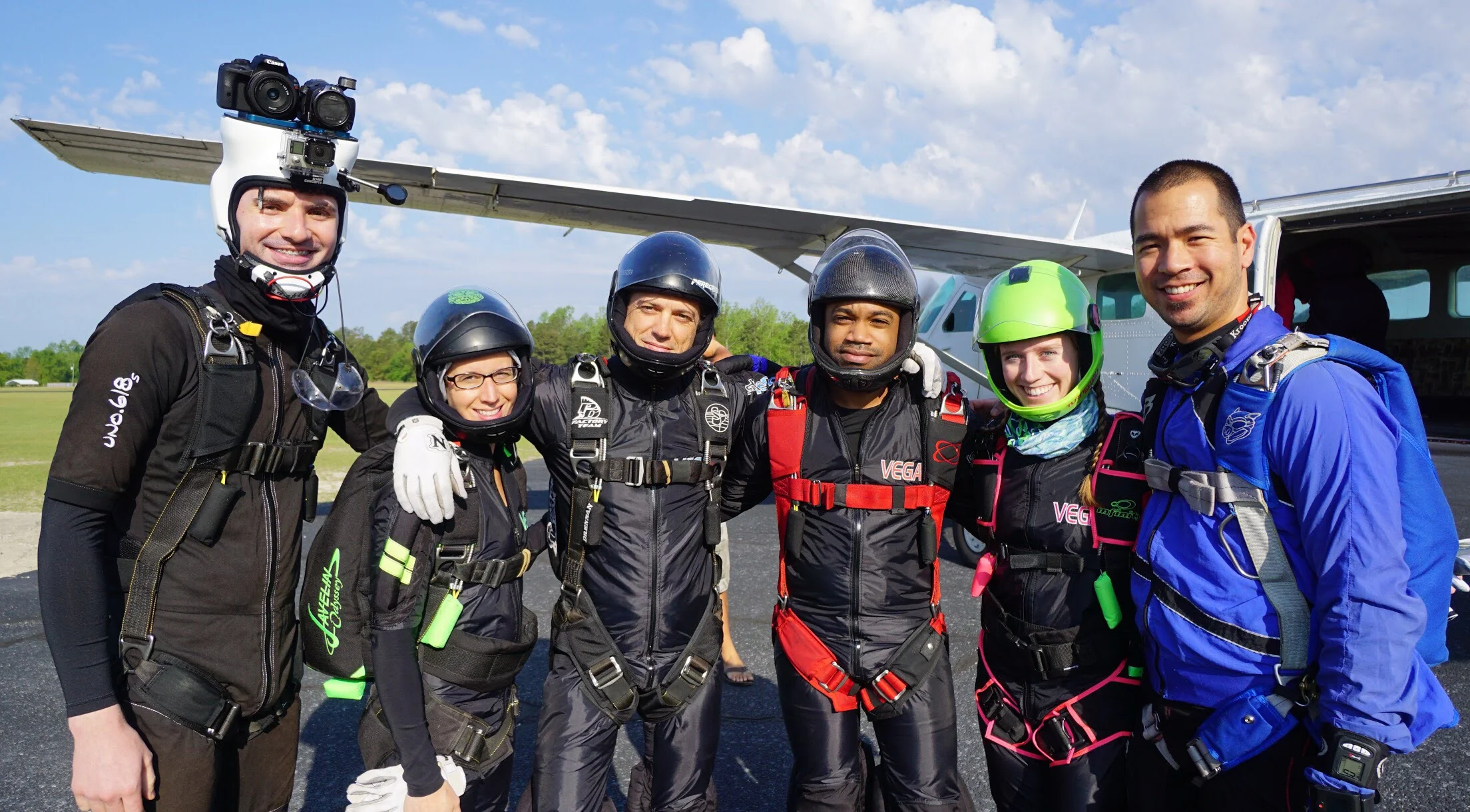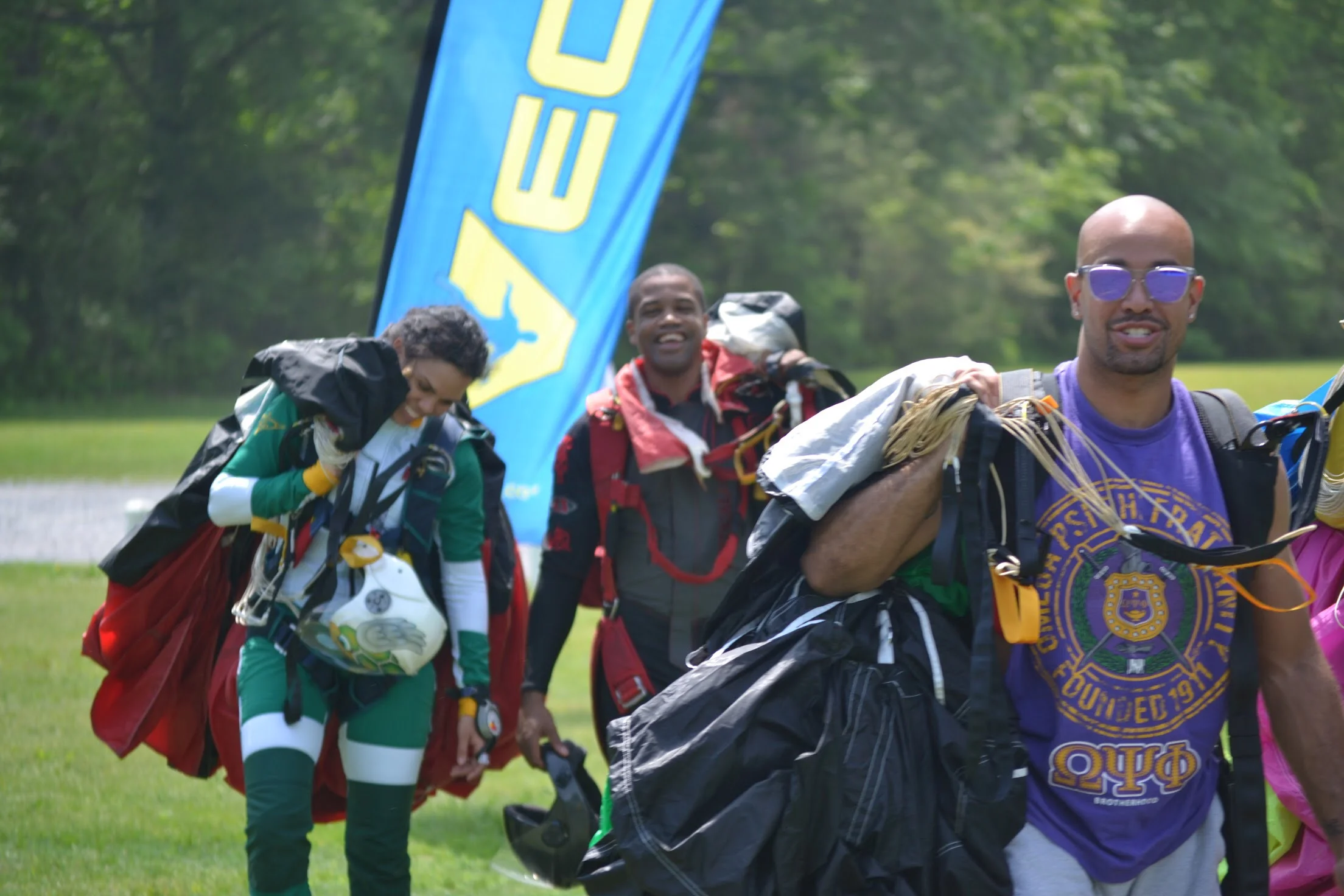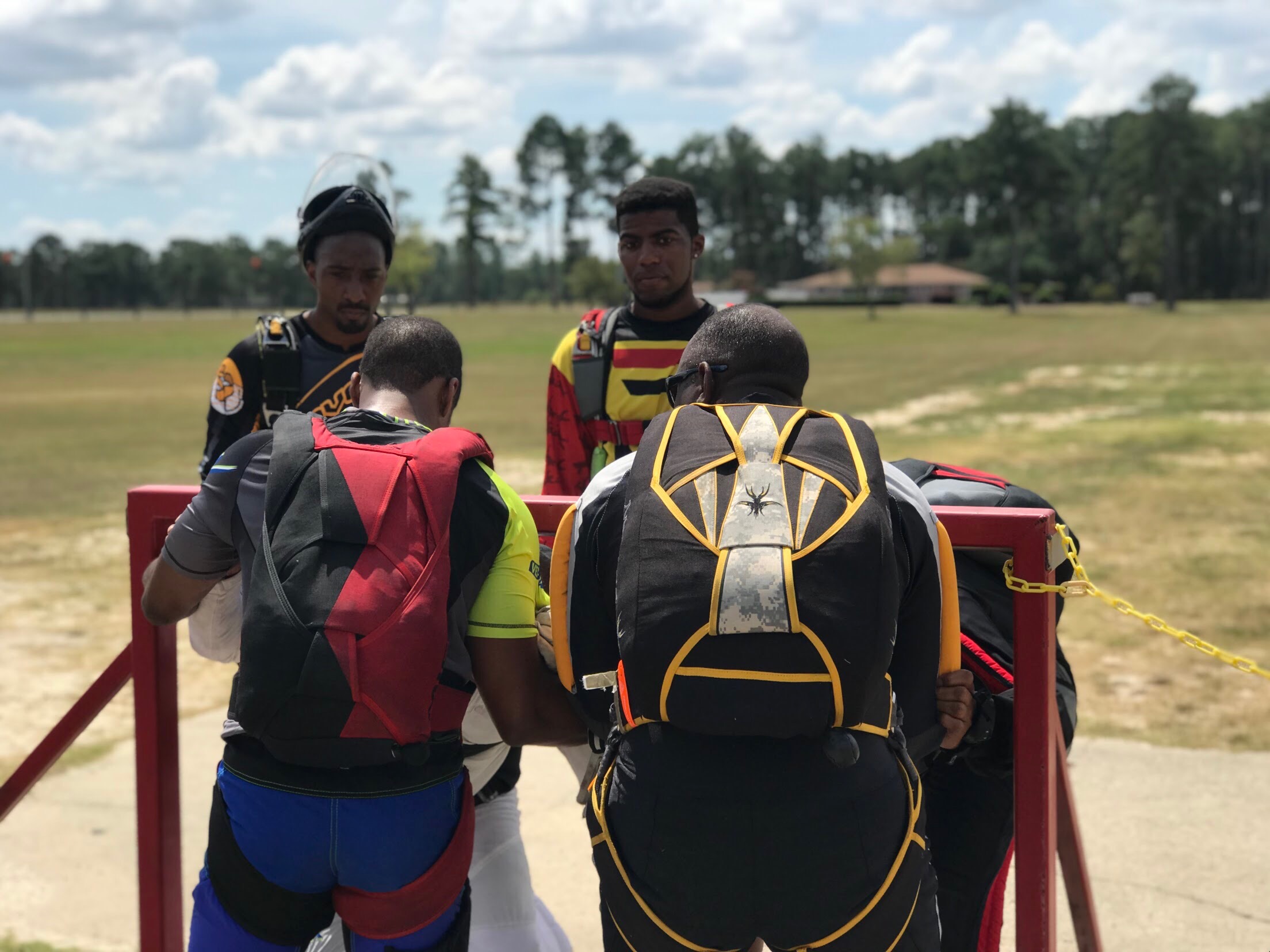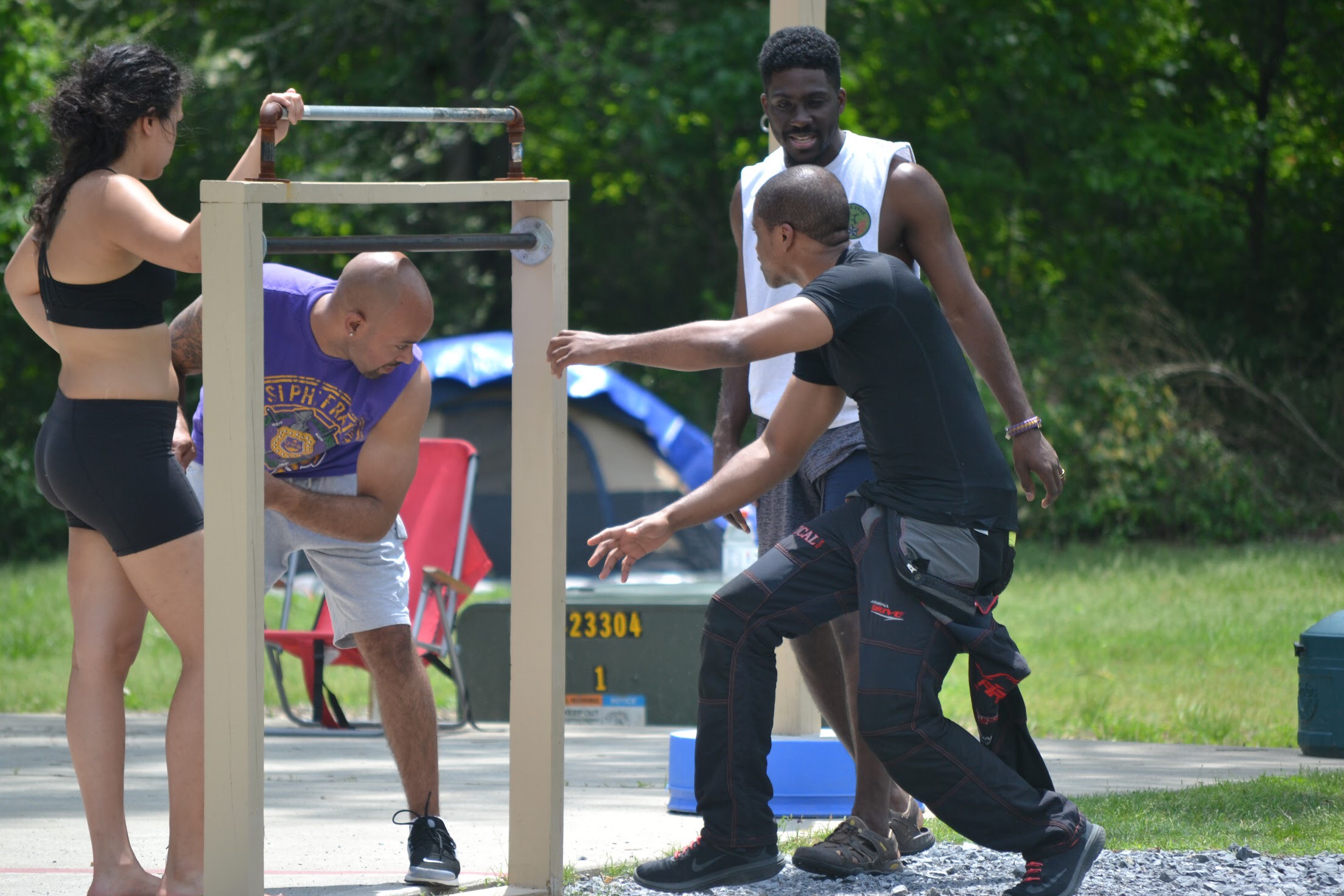In Pursuit of Mindfulness with African American Skydiver Nicholas Walker
Photo credit: Elliot Byrd
Nicholas Walker is one of a handful of African American competitive skydivers in the United States. He’s also a 3rd generation military veteran who first learned how to survive, adapt and thrive through a childhood that spanned two continents, six schools and almost losing a parent—twice.
With 10+ years of experience and over 1,050 jumps Nick is redefining a space that has been characterized, at least in part, by the absence of skydivers of color. He’s pushing boundaries for African Americans in the sport both on the podium and as a founding member of Team Blackstar Skydivers, a 270 member organization of skydivers of color from around the world.
At just over 5’9” with medium brown skin, close cropped hair and glasses, Nick doesn’t look like your typical adrenaline junkie. He looks like a mid-30s professional—which he is. By day, he works in information technology for the Department of Veteran Affairs; on the weekends, he frequently travels to drop-zones in North Carolina and Georgia in order to train with his skydiving team,Vega XP.
Nick (3rd from right) poses for a photo along with Vega XP team members at a drop-zone in North Carolina. Photo credit: Elliot Byrd
Nick competes in a type of formation skydiving known as 4-way relative work (RW), or 4-way RW for short. Relative work, also known as belly-flying, emphasizes the basic fundamentals of human flight. To become a licensed skydiver you must first learn to fly relative to other jumpers with your body positioned parallel to the earth. If you have motivational posters decorating your office at work, chances are you’ve already glimpsed formation skydiving in action. Think Keanu Reeves and Patrick Swayze in Point Break, or this clip from the 1994 thriller Drop Zone starring Wesley Snipes. It’s also the discipline represented in mind-blowing feats such as the 400-way world record set in Thailand in 2006.
Competitive 4-way RW skydivers exit the plane linked while a fifth skydiver ‘flies camera.’ The four teammates then have 35 seconds to complete the dive draw, a pre-determined series of static formations (randoms) and turns (blocks), as many times as possible. After ten rounds, the team with the highest number of points wins.
While most skydivers master the basics of RW before moving on to different disciplines, this is not a universal truth. Newer disciplines like free-flying, angle-flying and wing-suiting have strong sub-cultures that appeal to many younger jumpers. They’ve disrupted and re-shaped the competitive skydiving scene which bares little resemblance to the 1960s and 70s when belly-jumpers flocked to Pope Valley Parachute Ranch and Skydive Perris to compete in relative work. And it doesn’t stop there. As the sport continues to evolve, some of the newest forms of skydiving are actually taking place in commercial wind tunnels around the world in destinations like Bahrain, the United Arab Emirates and Singapore.
Then there are skydivers like Nick who fall in love with relative work; refining over years the precision and speed required to compete in 4-way, 8-way and 16-way RW or participating in big way camps in order to secure an invitation to world record formation skydiving jumps.
Nicholas (center) at a 2017 Team Blackstar meetup near Atlanta. (Photo credit: Jackie Sylvester)
People skydive for a variety of reasons. For Nick, the reason is simple: skydiving allows him to stay in the moment. Competitive 4-way RW gives him 35 seconds at a time of being fully present in life—no stress, no distractions, no multitasking. The past and future fade away; the only thing that matters is the dive flow—a series of clockwork like movements between four jumpers who turn and spin relative to one another while free-falling at 120 mph.
While skydivers are often maligned as “reckless thrill seekers” by the media, manyof them actually feel similarly—that jumping from perfectly good airplanes is a great way to slow down. Skydiving is just one method of unplugging and practicing mindfulness—a goal that can be increasingly elusive in a world that rewards multi-tasking, extraversion and 24/7 digital connectivity.
Nick (2nd from right, middle row) moved from Iceland to a high crime, low median income neighborhood in southeast DC where marching band became an unlikely outlet.
For experienced jumpers like Nick, the sport is an opportunity to slow down—not altogether different from taking time to enjoy a morning coffee or spending a few extra minutes in Child’s Pose. Free-fall brings a sense of physical self awareness that may be difficult to find at the office. For many skydivers, free-fall is also a way to recapture the playfulness, creativity and curiosity that we typically shed upon entering adulthood. Even after 10 years in the sport, Nick still loves the opportunity to slow down by speeding up.
This is his story.
Keflavík, Iceland
Keflavik, Iceland.
Nicholas was born into an African-American military family in Fairfield, California. Both of his parents were non-commissioned officers in the Air Force who fell in love while on assignment in Phoenix, Arizona. Then they fell out of love. His mom transferred to Griffith Air Force Base, New York where she met Howard, who has been Nick’s dad since he was two. Right away it was a good match. They married a year later when Nick turned three and had Nick’s little brother, Eugene, when Nick was four. Howard adopted Nick along with his older brother, Nate. Meanwhile his mom got out of the military and committed to raising the three boys as a stay-at-home mom.
When Nick was seven, his mom suddenly fell ill. One moment she was alert and talking; the next moment she collapsed and was unresponsive. Nick and his older brother dialed 911. The fire department arrived along with emergency medical personnel who resuscitated his mother. They transported her by ambulance to the hospital where she underwent emergency surgery for a ruptured appendix. The next day the boys were featured in the local paper. The fire department even came by to deliver toy fire trucks. That experience explains a lot about Nick. Everything about him is calm, deliberate, cool under pressure.
When Nick turned 11 the family moved to Keflavík, Iceland—a small, windswept 16th century fishing village that once housed a critical Allied air base during World War II. The air base later became the U.S. Naval Air Station Keflavík.
Nick (far left) coaches Team Blackstar skydivers on how to properly conduct a linked exit. Harrison Wallace (second from right) started skydiving in 1972. Dónte Caul (2nd from left) began skydiving in 2018.
Year round, gale force winds meant that smaller children weighing less than 120 lbs had to be escorted by their parents to school to prevent them from blowing away—Nick was one of them. A security patrol drove around the base each morning on the lookout for new families whose children would occasionally end up pinned to the security fence. The Icelandic summers were beautiful and long with almost 21 hours of daylight compared to the brutal winters where the sun barely rose before dipping back below the horizon. Kids will adapt to anything and Nick was no exception.
At the time the idea of an African American family living in Iceland didn’t seem that out of the ordinary. He was a small kid who made friends fast—a diverse group of military brats whose parents were all in the Air Force and Navy. He studied French, learned how to play the saxophone and competed in soccer, kickball and track against Department of Defense schools all over Europe. Locally, they were no match for the Icelandic teams and their statuesque students. The way Nick explains it, the contrast between Icelanders and the beautiful Icelandic countryside was stark and poetic: “the trees in Iceland were small due to the high winds, the locals were not.”
Nick’s life was privileged compared to a lot of Americans back home in the U.S. On the weekends, they joined other Air Force and Navy families for C-130 space available flights to Germany and Holland. This was just another day in the life of an U.S. Air Force family; but it didn’t last.
Nick (2nd from right) poses for a photo along with Team Blackstar skydivers at a recent meet-up in North Carolina. Photo credit: Danielle Williams
Marching Band
After a few years, the family of five left Europe and moved back to the U.S. to southeast D.C. They lived in Ward 8 close to his dad’s new assignment at Bolling Air Force Base. The culture shock was pretty jarring. Nick and his two brothers were enrolled in District of Columbia Public Schools (DCPS), one of the worst school systems in the U.S. at the time.
In the early 90s, Washington D.C. was known as the “murder capital of the United States.” Despite the overall decline of homicides in the 1990s, Black kids living in D.C. were being murdered at a rate disproportionate to the rest of the population. During the four year period between 1998-2002, a total of 744 murders were recorded in DC; more than 92% of those victims were African American and 18.8 % of homicide victims were 15-19 years old even though that age group made up only 6.6% of the population. DCPS were unable to provide safe learning environments for the most vulnerable students, and many of the most vulnerable students were living in Ward 8.
Nick adjusts the straps on his parachute rig prior to boarding the jump plane in North Carolina. Photo credit: Danielle Williams
Nick was enrolled in Charles Hart Middle School, a predominantly Black school located in a high crime, low median income area. Moving to Southeast D.C. meant a lot of firsts for the Walker kids. It was the first time that he realized that he had an accent—the wrong accent. He didn’t sound anything like his classmates. Other Black kids had a field day with the fact that he “talked White,” “acted White,” and “dressed White.” He got bullied a lot at first, mostly by other kids his age who were trying to mess with him. They would ask him to swear and then laugh uproariously because he couldn’t even say “fuck” properly.
But this isn’t a story about how Nick got picked on as a kid; or about how a Black kid from a poor neighborhood overcame adversity. Something unexpected happened next. And that unexpected thing was his saxophone. Nick, a resilient kid and a shrewd observer, realized that music was his path to acceptance. As it turned out, his saxophone lessons in Iceland were about to pay off.
In the late 1990s, marching bands were a big deal and a source of pride for District of Columbia Public Schools. They still are; even though gun violence sells more papers and gets more clicks online. Local high schools and middle schools participated in the annual D.C. battle of the bands parade. Nick joined the middle school marching band where he played the saxophone. That didn’t quite put him on the level of football players, but it meant he was now off limits for bullies.
In 9th grade Nick matriculated from Hart Middle School and enrolled at Ballou High School. It’s also located in Ward 8 in a low income, high crime neighborhood where shootings and stabbings made the nightly news. In 1998 Ballou was ranked as one of the most dangerous schools in the US. It’s still notorious for gang violence; the school itself is overcrowded and under resourced with high teacher turnover and high student absenteeism.
Eight Ballou students were either shot or stabbed to death during the September 1999 to June 2000 school year including Nick’s bandmate Teddy Garvin. Between 1990-1999, five to seven Ballou students were murdered each year. Once on his way to lunch, he watched a student get stabbed because he refused to relinquish a new Eddie Bauer jacket. Another day, school officials kept Nick and other students on the bus because a student’s body had been dumped in a ditch near the bus offloading area.
Nick (far left) poses for a photo with other Team Blackstar Skydivers during a 2018 meetup. Photo credit: Danielle Williams
Drug use and gang violence were common and the psychological stress of being constantly exposed to gun violence made learning difficult. Nick remembers attending high school French class where none of the students actually spoke French. One day the teacher wrote out an assignment in French on the chalkboard. When Nick quietly opened his book and began reading silently the other kids in the class were genuinely shocked, uttering “what are you doing man? You can read that?”
The unabated violence prompted Nick’s parents to send his older brother to upstate New York where he could live with his grandparents and finish out high school. Meanwhile, Nick adapted as well as he could to his new environment. He explains that “I’ve always been a bit of a chameleon whereas my brother was more like ‘you’re going to hell if you don’t believe in the Ten Commandments.’ That tended to rub folks the wrong way.”
While his parents had concerns about his older brother’s safety they reasoned that Nick and his younger brother Eugene would be fine. And Nick was fine for the most part. He was resourceful and intelligent and he kept his head down. After a year and a half at Ballou, his parents moved the family to Maryland where they briefly enrolled him in a private school. The environment there was more conducive to learning although Nick was not impressed, “the students weren’t any better—you could get your hands on any kinds of drugs you wanted—they just had more money, more resources.” He immediately dropped marching band; “there was no reason to be in the band in anymore because no one in Maryland cares about band.” He wasn’t wrong.
Nick (left, front row) jumps an 84 sq ft Valkyrie high performance parachute.
His family moved again—this time to Waldorf, MD where he was enrolled at McDonough High School. The beginning of his junior year, his older brother Nate began college. Even though “kids aren’t supposed to know” Nick witnessed the financial strain that college loans put on his family. “Even though we were in the military and had more opportunities than most people” he could see how his parents struggled.
Learning How to Skydive
Then September 11, 2001 happened. Nick was a senior in high school at the time; his mom was working at the Pentagon. She left the house early each morning before he woke up in order to beat the traffic. That morning he got to school in time to watch the breaking news as the second hijacked plane hit the South Tower of the World Trade Center. It was 9:03 a.m. Thirty-four minutes later American Airlines Flight 77 was deliberately crashed into the Pentagon. As soon as he heard the devastating news, Nick walked out of school and caught a ride home. The entire way home, he could only think of one thing: his mother was dead.
Video of Vega XP from the 4 way intermediate category, 2017 Skydiving National Championship in Perris, California
To his surprise, when he arrived home he found her car parked in the driveway in it’s usual spot. Nick ran inside, sobbing. His mother’s first instinct was to yell at him for skipping class. It wasn’t until she turned on the television that she realized what had occurred. She was safe—but only because, instead of going to work that day, a migraine had caused her to turn her car around, drive home and call in sick instead.
A few months later, Nick enlisted in the U.S. Army. It was his senior year and his parents were furious. Never mind the fact that they had both enlisted when they were around the same age. This was different. Post-9/11 geopolitics were a lot scarier and his chances of being deployed to a combat zone were a lot higher. Still, Nick felt it was the best option. In addition to serving his country, the Army would provide money for college—something he wanted but knew wasn’t an option financially for his family. He scored high enough on the ASVAB, an entry exam for new recruits, that he could choose whatever military occupational specialty he wanted. So he chose information technology.
Video Vega XP from the Advanced 4 way category 2018 Skydiving Nationals. Video courtesy of USPA/OmniSkoreHD
Later on at boot camp, his drill sergeant asked for volunteers to go to Airborne School in order to become Army paratroopers. Nick volunteered on the spot but his drill sergeant insisted that he wouldn’t need Airborne ‘as a computer guy.’ So he received orders for his unit instead. When he arrived at his first assignment, 7th Special Forces Group, he promptly got yelled at for ‘not being Airborne.’ Go figure. Nick went on to complete 40 static line parachute jumps with the Army—jumping out of everything from lumbering C-17s to noisy twin engine CASA-212s and the Army’s workhorse, UH-60 Blackhawks.
Nick served for six years in the Army with 7th Special Forces Group and a Tier 1 JSOC unit. He deployed six times, spending a total of 3.5 years “down range” in Afghanistan and Iraq. He started skydiving in 2008, the same year he transitioned from the Army back to civilian life. A year later in 2009, he began competing with his first four way team, STF Velox.
The majority of African American skydivers are also veterans. You could easily assume that Nick’s interest in parachuting is similar to his interest in marching band—a way to survive and adapt to a new environment—especially in the military were bravery is currency and parachuting is a coveted skill reserved for elite units. But you’d be wrong.
Photo credit: Ian Drennan
According to his recent interview with Team Blackstar Skydivers, skydiving provides what other sports he tried over the years couldn’t: a sense of peace. Nick also loves the strong sense of community and the friendships that he’s built in the sport. After surviving two combat zones, 9/11, and six different schools Nick is pretty adept at adapting to new environments. So learning to skydive and even surviving the awkward, fumbling early years and building a new set of skills came naturally. Mindfulness was just a bonus.
Being “the only one” doesn’t bother him. When other skydivers ask him his story or comment that “they don’t get many African American competitors” he doesn’t feel out of place or tokenized. Plus, he sort of enjoys the extra challenge of flying “at a level where people get over their initial reaction that I’m a Black guy and recognize that I’m a good skydiver.” There’s something worthwhile in challenging expectations.
With it’s high cost of entry and low minority participation, the reality is that Black skydivers are more likely to be mistaken for tandem customers than recognized as competitors. Then there are moments like these that make up for it: one day while he was re-packing his parachute after a jump, a Black tandem student approached Nick and asked to take a photo of him in order to prove to her friends that Black skydivers do exist!
Nick (far right, front row) coaches a group of skydivers during a 2017 Team Blackstar Skydivers meetup in Georgia. Photo courtesy of Jackie Sylvester
Competitive Skydiving
Fast forward ten years to present day, Nick is still competing. These days his canopy is a lot smaller and his experience level a lot higher. Nick jumps a small Vector 3 container which contains two high performance canopies: a Valkyrie 84 sq ft. main parachute and an Optimum 113 sq ft. reserve.
In the skydiving community his parachute translates roughly to “highly experienced skydiver, please don’t touch my gear.” It’s fun to fly, super responsive and agile. It’s also small enough that simple malfunctions become dangerous—fast. But it’s perfect for high performance landings and for simply landing fast enough to switch out rigs and make the next plane load during team training—when every jump counts.
At Skydiving Nationals in 2017, Nick’s current team Vega XP beat 40 other teams to take home the gold for Intermediate 4-way RW. It was a hard won victory, after an intense year of training and competing up and down the east coast. The personal and financial costs are immense: semi-professional skydiving teams average 15 tunnel hours and 200 training jumps per year at a cost of roughly $10,000-12,000 per individual. Then there are traveling costs, hotels, competition fees, etc. Without sponsorships from big brands, training and competition can become prohibitively expensive.
Even when they secure sponsorships, those sponsors tend to be other small businesses within the skydiving community. While the Red Bull Air Force may occasionally capture the public’s imagination, you’ll have to search far and wide to find a competitive skydiver sponsored by a household brand like Nike, Oracle or Under Armour. It just doesn’t happen. The end result is a lot of hard work and a lot of hustle.
Nick (2nd from left) pies a jumper; according to skydiving tradition, jumpers are pied on the occasion of their 100th, 1,000th and 10,000th skydive! Photo courtesy of Danielle Williams
In 2018, Nick and his Vega XP teammates sold t-shirts and coached indoor skydiving camps at wind tunnels in Atlanta and North Carolina to raise money.
Skydiving is similar to mountaineering and other technical adventure sports in that you can’t learn to skydive or climb a mountain by reading about it in a book. You have to actually do it and preferably learn from someone with way more experience and knowledge. In recent decades, private and group instruction has become available through an annual circuit of indoor and outdoor skydiving camps taught by semi-professional and professional teams. For part-time competitors balancing a 9-5 with coaching and competing it can be a lot. But winning requires training and training costs money!
After winning gold in 2017, Vega XP moved up to the Advanced category in 2018. Last September they finished middle of the pack against other semi-professional 4-way teams. Nick and his teammates are already training for 2019 Nationals. They have a busy year ahead of them which includes welcoming a new team member, and competing at indoor and outdoor competitions in North Carolina and Florida in the run-up to the 2019 Skydiving Nationals. If you look at the event posters, you probably won’t see anyone who looks like him—but he’ll be there, surviving and thriving and providing valuable representation for the next generation of adventure athletes of color.
Photo credit: Elliot Byrd
























I also know that hunger disproportionately impacts Black Americans who make up nearly 30% of SNAP recipients. So why would I celebrate cuts to a program that is a lifeline for so many people?